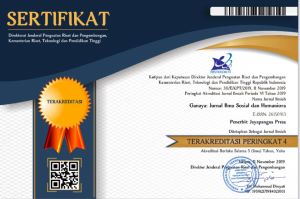Urgensi Pendidikan Agama Hindu Terhadap Kebijakan Pemerintah Tentang Pendidikan Agama Dan Keagamaan
DOI:
https://doi.org/10.37329/cetta.v4i3.1413Keywords:
Urgency, Hindu Religious Education, Government PoliciesAbstract
Education is closely related to national development and is directed at the development of all Indonesian people. As an effort to implement the National Education System Law, the government hereby pays great attention to religious education. This study aims to determine the urgency of Hindu religious education on government policies regarding religious and religious education. The method used in this study is a qualitative method using descriptive analysis techniques, with data collection techniques carried out through library research. The results of the study stated that Hindu religious education has a function as a motivator and dynamist, can encourage the creativity of students to do good and right to achieve their life goals, as stated in the Vedas namely Moksartham Jagadhitaya Ca Iti Dharma, meaning that people can practice Hinduism, understand, If you live and practice it, then the purpose of life, namely physical and spiritual well-being, will be achieved in this world and the next life. It is said how great the function of Hinduism is in shaping the character of the nation's children, especially in ethics, morality and morality, developing spirituality in everyday life in order to achieve their life goals. In this context, the government always lists religious education as one of the compulsory subjects that must be taken from elementary school to university. This is reflected in the laws and regulations of the 1945 Constitution and the National Education System Law, as well as other laws and regulations.
References
Armini, I. A. (2019). Urgensi Pendidikan Agama Hindu Bagi Anak. Pratama Widya: Jurnal Pendidikan Anak Usia Dini, 2(2), 58-70.
Aryana, I. M. (2021). Urgensi Pendidikan Karakter (Kajian Filsafat Pendidikan) . Kalangwan Jurnal Pendidikan Agama, Bahasa dan Sastra, 11(1), 1-10.
Karda. (2007). Sistem Pendidikan Agama Hindu. . Surabaya: Paramita.
Prasetiawati, E. (2017). Urgensi Pendidikan Multikultur untuk Menumbuhkan Nilai Toleransi Agama di Indonesia. Tapis: Jurnal Penelitian Ilmiah, 1(02), 272-303.
Pratiwi, N. K. (2018). Peran Pendidikan Agama Hindu Dalam Membentuk Kepribadian Siswa. Guna Widya: Jurnal Pendidikan Hindu, 2-5.
Rama, S. (2002). Hidup dengan Para Yogi Himaalaya. Surabaya: Paramita.
Santika, N. W. (2018). Pendidikan Agama Hindu Sebagai Dasar Dalam Pembentukan Karakter. Satya Widya: Jurnal Studi Agama, 1(2), 153-163.
Setyaningsih. (2019). Peran Pendidikan Agama Hindu Dalam Membentuk Kepribadian Siswa . Widya Aksara, 23 (2).
Suda, I. K. (2017). Pasraman Sebagai Energi Pendidikan Agama Dan Seni Hindu Dalam Dominasi Dan Hegemoni Pendidikan Modern. SOSHUM: Jurnal Sosial Dan Humaniora, 7(3), 364-373.
Sudarsana, I. K. ((2018, January 9). ). Pengantar Pendidikan Agama Hindu. Retrieved from https://doi.org/10.31227/osf.io/35qkb
Sutarwan, I. W. (2018). Urgensi Pendidikan Karakter Bagi Generasi Bangsa di Era Perkembangan Teknologi. Dharma Duta, 16(1).
Downloads
Published
How to Cite
Issue
Section
License
An author who publishes in the Cetta : Jurnal Ilmu Pendidikan agrees to the following terms:
- Author retains the copyright and grants the journal the right of first publication of the work simultaneously licensed under the Creative Commons Attribution-ShareAlike 4.0 License that allows others to share the work with an acknowledgement of the work's authorship and initial publication in this journal
- Author is able to enter into separate, additional contractual arrangements for the non-exclusive distribution of the journal's published version of the work (e.g., post it to an institutional repository or publish it in a book) with the acknowledgement of its initial publication in this journal.
- Author is permitted and encouraged to post his/her work online (e.g., in institutional repositories or on their website) prior to and during the submission process, as it can lead to productive exchanges, as well as earlier and greater citation of the published work (See The Effect of Open Access).
Read more about the Creative Commons Attribution-ShareAlike 4.0 Licence here: https://creativecommons.org/licenses/by-sa/4.0/.





